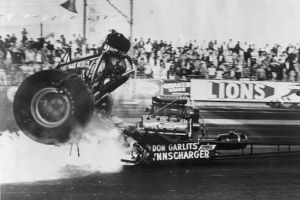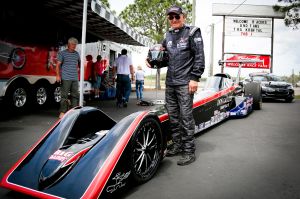Swamp Rat
Wiki Waiting to be Created!
This Wiki is only the format of a yet to be created topic. If you wish to begin this topic, click the Edit tab and follow the instructions in the comments. It is suggested that those who are new to editing topics first read the topics with links in the sidebar, in the Understanding Wikis topic box.
Contents
Swamp Rats
Big Daddy Don Garlits built a number of dragsters over the years named Swamp Rat (with their number). This wiki needs collaborators to research and author information on each of the Swamp Rats.
Swamp Rat 1
need info on Swamp Rat 1
Swamp Rat 2
need info on Swamp Rat 2
Swamp Rat 3
need info on Swamp Rat 3
Swamp Rat 4
need info on Swamp Rat 4
Swamp Rat 5
need info on Swamp Rat 5
Swamp Rat XIII
On March 8, 1970, at Lions Drag Strip, Garlits was driving Swamp Rat XIII, also called the Wynnscharger, a slingshot rail, when the vehicle suffered a catastrophic failure. The two-speed transmission Garlits was developing exploded and took a piece out of his right foot, while the car broke in half in front of the cockpit; he was out for the remainder of the season. In an interview by Florida Trend, Garlits said this of the incident: "In 1970, the transmission exploded in my dragster on the final run, and it cut my foot off and cut the car in two. That’s when I drew up plans for what I thought would be a championship rear-engine car. I would go out to the shop in Seffner on my wheelchair, saw stuff out on the band saw and make the parts."
Swamp Rat XIV

This is an article copied from Bangshift
There are few if any other singular race cars on the planet, in any form of racing that were the catalyst for as much change as Don Gartlits’ Swamp Rat 14, his first rear-engine dragster.
On March 8, 1970 at Lions Drag Strip, Don Garlits suffered a horrific transmission failure in his front-engine dragster. The explosion resulted in a partial amputation of his foot and shrapnel nearly severing the arm of a woman in the stands. It also wounded a young boy.
One must remember, though, that Garlits had suffered through horrible fires, wrecks, and other badness in his career, but this time it was different. This was a permanent, disfiguring, potentially disabling injury. Something had to be done. While in his hospital bed watching episodes of Star Trek with Tom “Mongoose” McEwen, Garlits formulated his plan for a rear-engine car that would be competitive, quick, and most importantly, safe.
While recovering and considering the project, Garlits actually climbed back into his freshly repaired front-motor car in Bristol, Tennessee, only a scant three months after his accident. He was still not cleared to drive by medical people but with doubts lingering in his own mind about his future in drag racing, he saddled up and promptly went low ET of the meet.
Had it not been for one of the most horrifying wrecks ever caught on film at the 1970 US Nationals, Garlits may well have shelved the whole idea. Having lost to Jim Nicoll in the semi-finals of that race, Garlits watched with interest as Nicoll raced Don Prudhomme in the final. At the traps and at full song, the clutch in Nicoll’s car exploded, rip-sawing the chassis in half just in front of the drivers’ area and sending the front of the car on an eerie track next to Prudhomme’s slowing machine. Meanwhile, Nicoll was flipping like a bowling ball and most everyone suspected he was dead. That’s the way those things tended to end. Shockingly, he lived. Having seen that, Garlits left the track with the stated purpose of bringing out a rear-engine car.
Upon arriving backing Florida, Garlits sat down with his trusted cadre of advisors, TC Lemons and Connie Swingle. Swingle suggested maintaining the then-standard wheelbase of 215 inches, Garlits decided on the driving position being reclined and very low in the car. By the winter they were making test laps and running into a problem that had vexed constructors of rear-engine cars to this point: they were unsteerable at speed. No matter how light the touch, the car would veer wildly from side to side.
Finally Garlits let Swingle know of this problem, and without hesitation, Swingle suggested slowing the steering from the normal front-motor ratio of 6:1 to a far slower 10:1 ratio. That was the ticket.
In December of 1970, Garlits dragged the new car to Orlando and promptly laid down a monster 6.80 lap and secured the track record. Mystery solved.
Garlits was quoted as saying of the event, “We drove back to Tampa that afternoon and if anyone had been with us they would have thought we were drunk. After the long hard hours of work, the success of that last run had put us all on a natural high. Swingle kept saying, ‘Gar, you’re gonna kill ‘em,’ and TC just smiled and said ‘Wait till them Californians see what the ‘Okies’ built. Myself, I was just plain happy and very excited. I knew I would be racing a lot longer now and the fear of sitting behind a fire-breathing, nitro-burning Dodge Hemi was ‘behind’ me. In fact, all my troubles were behind me.”
The boys took the car out to California a couple weeks ahead of the Winternationals to sort out any last-minute bugs. The results of the tune-up races were two final-round appearances and two final-round losses (To the same guy! Gary Cochran can forever tell his grandkids that he whipped Garlits two weeks in a row, a rare claim indeed) which Garlits blamed on himself as being a bit gun shy. He was reliving the accident in his brain every time he mashed the pedal.
The two races got him comfortable and when he rolled into Pomona he was well equipped to kick ass. And he did, winning the race in relatively easy fashion. The guys who snickered when they rolled through the gate were now examining the car and making plans for their own. They needed to. The rear-engine car was so successful that the last NHRA National event win for a slingshot dragster happened in 1972 at the NHRA Grandnational in Canada with Art Marshall at the helm of the digger.
As the LA Times famously wrote after Pomona, Garlits’ car had turned the collective group of slingshots into, “a million dollar junk pile.”
It’s kind of an accepted deal that if you’re a drag racing geek, slingshots are supposed to be your “favorite” type of rail. Well, I’m not buying it.
My absolute favorite cars are the very early rear-engine cars like Garlits’. They are spindly and low and look like long go-karts with blown Hemi motors. Just the sight of a rear-engine car idling gives me the shivers. They heave and jiggle and bounce around like they’re made of wet spaghetti and I love it.
That’s the story of Swamp Rat 14 in a nutshell. Garlits would churn out a bunch of improved designs on this theme and his Swap Rat 22 would become the first car to 250 mph in the quarter mile and set ET records that weren’t touched for years.
Yeah, this piece of iron qualifies as historic. end of Bangshift article
Swamp Rat 37
In May 2014 at age 82, Garlits set a 184 mph speed record with Swamp Rat 37, a 2,000 hp battery-powered EV dragster.
Swamp Rat 38
In July 2019 at age 87, he set a new quarter-mile record of 189.03 mph with Swamp Rat 38, a 1,500 lb dragster with a battery-powered 800 hp electric motor.
This Wiki is Under Construction, and can use your help!
Please take a moment to add any information you might have on this topic. It is through this type of Member collaboration that the MoparWiki will grow into being the Ultimate Mopar Infobase. The links contained in the Understanding Wikis box in the sidebar can help you get started.
Random Page | Longest Wikis | Oldest Wikis | Newest Images | Newest Wikis | List of Categories | List of Every Freakin Wiki
- Register to Edit
- It takes less than 5 minutes to request registration for editing, and we try to approve within 24 hours. Click the Register Link in the Top Bar.
- MoparWiki Help
- While editing Wikis may at first glance appear a little overwhelming, it really isn't. You will find this site's HELP (link found in the sidebar) to be very strong and easy to understand. The best way to start is with small edits and working on your user page -- and you will become a Pro in no time.
References
This Wiki requires References
The information in this wiki will have more creditability with some references to back it up




